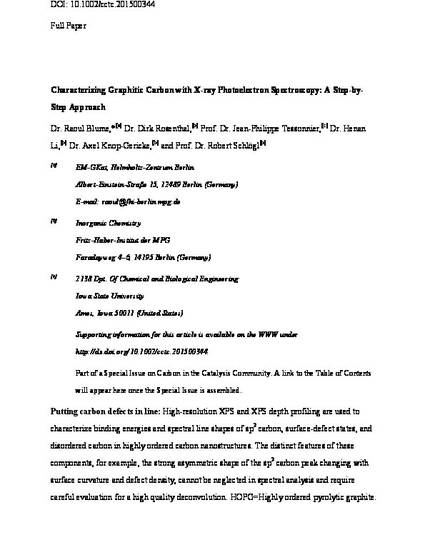
X-ray photoelectron spectroscopy (XPS) is a widely used technique for characterizing the chemical and electronic properties of highly ordered carbon nanostructures, such as carbon nanotubes and graphene. However, the analysis of XPS data—in particular the C 1s region—can be complex, impeding a straightforward evaluation of the data. In this work, an overview of extrinsic and intrinsic effects that influence the C 1s XPS spectra—for example, photon broadening or carbon–catalyst interaction—of various graphitic samples is presented. Controlled manipulation of such samples is performed by annealing, sputtering, and oxygen functionalization to identify different C[BOND]C bonding states and assess the impact of the manipulations on spectral line shapes and their binding energy positions. With high-resolution XPS and XPS depth profiling, the spectral components arising from disordered carbon and surface-defect states can be distinguished from aromatic sp2 carbon. These findings illustrate that both spectral line shapes and binding energy components must be considered in the analysis of potentially defective surfaces of carbon materials. The sp2 peak, characteristic of aromatic carbon, features a strong asymmetry that changes with the curvature of the sample surface and, thus, cannot be neglected in spectral analysis. The applied deconvolution strategy may provide a simple guideline to obtaining high-quality fits to experimental data on the basis of a careful evaluation of experimental conditions, sample properties, and the limits of the fit procedure.
Available at: http://works.bepress.com/jean-philippe_tessonnier/23/

This is the peer-reviewed version of the following article: Blume, Raoul, Dirk Rosenthal, Jean‐Philippe Tessonnier, Henan Li, Axel Knop‐Gericke, and Robert Schlögl. "Characterizing Graphitic Carbon with X‐ray Photoelectron Spectroscopy: A Step‐by‐Step Approach." ChemCatChem 7, no. 18 (2015): 2871-2881., which has been published in final form at DOI: 10.1002/cctc.201500344. This article may be used for non-commercial purposes in accordance with Wiley Terms and Conditions for Self-Archiving.